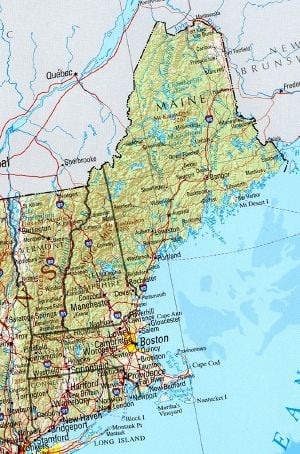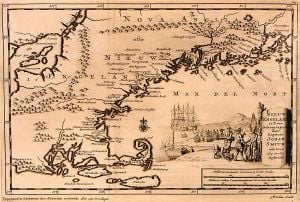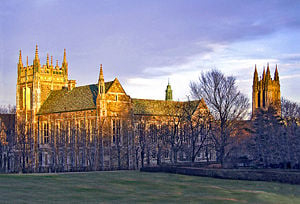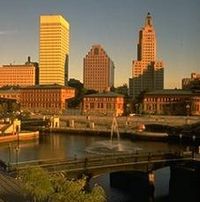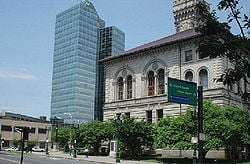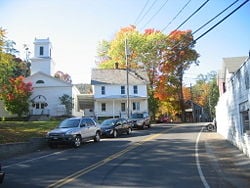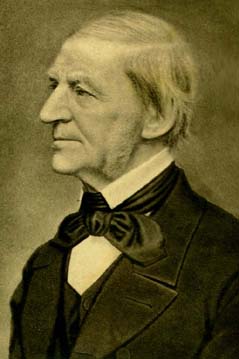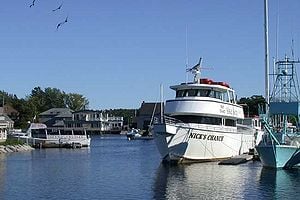New England
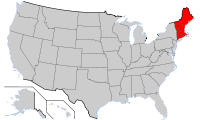 
| |
| Political history | |
|---|---|
| Chartering as Plymouth Council for New England |
1620-11-03[1] |
| Formation as United Colonies of New England |
1643 |
| Formation as Dominion of New England |
1686 |
| New York formally incorporated into the Dominion of New England |
1688-08-11[2] |
| As a result of the Glorious Revolution, Bostonians imprisoned the royal governor and others loyal to King James II, thereby ending the Dominion of New England. |
1689-04-18[3][4] |
| Regional statistics | |
| Largest city | Boston |
| U.S. States | Connecticut Maine Massachusetts New Hampshire Rhode Island Vermont |
| Area - Total |
71,991.8 sq mi (186,458.8 km²) |
| Population - Total (2006) - Density |
14,269,989[5] 198.2 people/sq mi (87.7 people/km²) |
New England is a region of the United States located in the northeastern corner of the country, consisting of the modern states of Maine, New Hampshire, Vermont, Massachusetts, Rhode Island, and Connecticut.[6]
In one of the earliest English settlements in the New World, English Pilgrims fleeing religious persecution in Europe first settled in New England in 1620, in the colony of Plymouth. In the late eighteenth century, the New England colonies would be among the first North American British colonies to demonstrate ambitions of independence from the British Crown, although they would later oppose the War of 1812 between the United States and Britain.
In the nineteenth century, it played a prominent role in the movement to abolish slavery in the United States, was the birthplace of American literature and philosophy, was home to the beginnings of free public education, and was the first region of the United States to be transformed by the Industrial Revolution.[7]
Geography
New England's long rolling hills, mountains, and jagged coastline are a consequence of retreating ice sheets from prehistoric times. The coast of the region, extending from southwestern Connecticut to northeastern Maine, is dotted with lakes, hills, swamps, and sandy beaches. Further inland are the Appalachian Mountains, extending through Connecticut, Massachusetts, Vermont, New Hampshire, and Maine. Among them, in the White Mountains of New Hampshire is Mount Washington, which at 1,917 m (6,288 ft), is the highest peak in the northeast United States. It is also the site of the highest recorded wind speed on Earth.[8] Vermont's Green Mountains, which become the Berkshire Hills in western Massachusetts, are smaller than the White Mountains. Valleys in the region include the Connecticut River Valley and the Merrimack Valley.
The longest river is the Connecticut River, which flows from northeastern New Hampshire for 655 km (407 mi), emptying into the Long Island Sound. Lake Champlain, wedged between Vermont and New York, is the largest lake in the region, followed by Moosehead Lake (Maine), Lake Winnipesaukee (New Hampshire), Quabbin Reservoir (Massachusetts), and Candlewood Lake (Connecticut).
Climate
Weather patterns are highly variable and climate varies throughout the region. Maine, New Hampshire, and Vermont have a humid continental short summer climate, with cooler summers and long, cold winters. Connecticut, Massachusetts, and Rhode Island, have a humid continental long summer climate, with hot summers and cold winters. Owing to thick deciduous forests, fall in New England brings bright and colorful foliage, which comes earlier than in other regions, attracting tourism by 'leaf peepers'.[9] Springs are generally wet and cloudy. Average rainfall generally ranges from 1,000 to 1,500 mm (40 to 60 in) a year, although the northern parts of Vermont and Maine see slightly less, from 500 to 1,000 mm (20 to 40 in). Snowfall can often exceed 2,500 mm (100 in) annually. As a result, the mountains of Vermont and New Hampshire are popular destinations in the winter, with numerous commercial ski resorts.[7][10]
History

New England's earliest inhabitants were Algonquian-speaking Native Americans including the Abenaki, the Penobscot, and the Wampanoag. Prior to the arrival of Europeans, the Western Abenakis inhabited New Hampshire and Vermont, as well as parts of Québec and western Maine. Their principal town was Norridgewock, in present-day Maine. The Penobscot were settled along the Penobscot River in Maine. The Wampanoag occupied southeastern Massachusetts, Rhode Island, and the islands of Martha's Vineyard and Nantucket.
Compared to other North American settlements, New England was sparsely populated and densely forested, leading European settlers to believe North America was a "virgin land."[12]
The Virginia Companies compete
On April 10, 1606, King James I of England issued two charters, one each for the Virginia Companies, of London and Plymouth, respectively.[13][14][15]
- Under the charters, the territory allocated was defined as follows:
- Virginia Company of London: All land, including islands within 100 Miles from the coast and implying a westward limit of 100 Miles, between 34 Degrees (Cape Fear, North Carolina) and 41 Degrees (Long Island Sound, New York) north latitude.[13][14][15]
- Virginia Company of Plymouth: All land, including islands within 100 Miles from the coast and implying a westward limit of 100 Miles, between 38 Degrees (Chesapeake Bay, Virginia) and 45 Degrees (Border between Canada and Maine) north latitude.[13][14][15]
- Realizing the obvious duplication (between Chesapeake Bay and Long Island Sound), the two companies were required to maintain a separation of 100 Miles, even where the two charters overlapped.[13][14][15]
These were privately funded proprietary ventures, the purpose of each being to claim land for England, trade, and return a profit.[16] Competition between the two companies grew to where their potential New World territory overlapped, and would be finalized based upon results.
The London Company was authorized to make settlements from North Carolina to New York, provided there was no conflict with the Plymouth Company’s charter.
The Popham Colony was planted by the Virginia Company of Plymouth. Unlike the Jamestown Settlement, it was not initially successful, and was abandoned after one year, though would later be revived. The Virginia Company of Plymouth's charter included land extending as far as present-day northern Maine.[17] Captain John Smith, exploring the shores of the region in 1614, named the region "New England"[18] in his account of two voyages there, published as A Description of New England.
Plymouth Council for New England
The "first landing" of the Mayflower Pilgrims was in Provincetown, Massachusetts on November 21, 1620, and their signing of the Mayflower Compact took place there.
The name "New England" was officially sanctioned on November 3, 1620, when the charter of the Virginia Company of Plymouth was replaced by a royal charter for the Plymouth Council for New England, a joint stock company established to colonize and govern the region.[19] Shortly afterwards, in December 1620, a permanent settlement was established at present-day Plymouth, MA by the Pilgrims, English religious separatists arriving via Holland. The Massachusetts Bay Colony, which would come to dominate the area, was established in 1628 with its major city of Boston established in 1630.
Banished from Massachusetts, Roger Williams led a group south and founded Providence, Rhode Island, in 1636. On March 3 of the same year, the Connecticut Colony was granted a charter, and established its own government. At this time, Vermont was unsettled, and the territories of New Hampshire and Maine were governed by Massachusetts.
New England Confederation
In these early years, relationships between colonists and Native Americans alternated between peace and armed skirmishes. Six years after the bloodiest of these, the Pequot War, in 1643 the colonies of Massachusetts Bay, Plymouth, New Haven, and Connecticut joined together in a loose compact called the New England Confederation (officially "The United Colonies of New England"). The confederation was designed largely to coordinate mutual defense against possible wars with Native Americans, the Dutch in the New Netherland colony to the west, the Spanish in the south, and the French in New France to the north, as well as to assist in the return of runaway slaves. The confederation lost its influence when Massachusetts refused to commit itself to a war against the Dutch.
Dominion of New England
In 1686, King James II, concerned about the increasingly independent ways of the colonies, including their self-governing charters, open flouting of the Navigation Acts, and increasing military power, established the Dominion of New England, an administrative union comprising all of the New England colonies. On August 11, 1688, the provinces of New York and New Jersey, seized from the Dutch in 1664, and confirmed on September 12, 1673, were added[2]. The union, imposed from the outside and contrary to the rooted democratic tradition of the region, was highly unpopular among the colonists.
Nevertheless, those two present states are reckoned as "greater New England" in a social or cultural context, as that is where Yankee colonists expanded to; before 1776. Indeed, the identity in that era changed once one moved to Pennsylvania, as the Pennamite-Yankee War attests to. Colonists from New England proper in that era, were rather well received in the Mohawk Valley and on Long Island in New York. To this day, the cultural legacy of New England is easy to detect by the vast majority of other Americans.
After the Glorious Revolution in 1689, Bostonians imprisoned the Royal Governor and other sympathizers of King James II on April 18, 1689, thus ending the Dominion Of New England de facto [3][4]. The charters of the colonies were significantly modified after this change in English politics, with the appointment of Royal Governors to nearly every colony. An uneasy tension existed between the Royal Governors, their officers, and the elected governing bodies of the colonies. The governors wanted unlimited authority, and the different layers of locally elected officials would often resist them. In most cases, the local town governments continued operating as self-governing bodies, just as they had before the appointment of the Royal Governors. This tension culminated itself in the American Revolution, boiling over with the breakout of the American War of Independence in 1775.
Region of the United States
The colonies were now formally united as newly formed states in a larger (but not yet federalist) union United States of America.
In the 18th century and the early 19th century, New England was still considered a distinct region, as it is today. During the War of 1812, there was a limited amount of talk of secession from the Union, as New England merchants, just getting back on their feet, opposed the war with their greatest trading partner - Great Britain.[20] The Hartford Convention of 1814 considered secession but failed to act on it.
For the remainder of the Antebellum period, New England remained distinct. Politically, it often went against the grain of the rest of the country. Massachusetts and Connecticut were among the last refuges of the Federalist Party, and when the Second Party System began in the 1830s, New England became the strongest bastion of the new Whig Party - the Whigs were usually dominant throughout New England, except in the more Democratic Maine and New Hampshire. Many of the leading statesmen - including most prominently Daniel Webster - hailed from the region. New England was also distinct in other ways. It was, as a whole, the most urbanized part of the country (the 1860 Census showed that 32 of the 100 largest cities in the country were in New England), as well as the most educated. Many of the major literary and intellectual figures produced by the United States in the Antebellum period were New Englanders, including Ralph Waldo Emerson, Henry David Thoreau, Nathaniel Hawthorne, Henry Wadsworth Longfellow, John Greenleaf Whittier, George Bancroft, William H. Prescott, and others.
New England was also an early center of the industrial revolution. Towns like Lawrence and Lowell, Massachusetts and Lewiston, Maine became famed as centers of the textile industry.
New England and areas settled from New England, like Upstate New York, Ohio's Western Reserve and the upper midwestern states of Michigan and Wisconsin, also proved to be the center of the strongest abolitionist sentiment in the country. Prominent abolitionists like William Lloyd Garrison and Wendell Phillips were New Englanders, and the region was also home to prominent anti-slavery politicians like John Quincy Adams, Charles Sumner, and John P. Hale. When the anti-slavery Republican Party was formed in the 1860s, all of New England, including areas which had previously been strongholds for both the Whig and the Democratic Parties, became strongly Republican, as it would remain until the early 20th century, when immigration would begin to turn the formerly solidly Republican states of Lower New England towards the Democrats.
New England has largely preserved its regional character, especially in its historic places. Its name is a reminder of the past, as many of the original English-Americans have migrated farther west. Today, the region is more ethnically diverse, having seen waves of immigration from Ireland, Québec, Italy, Portugal, Asia, Latin America, Africa, other parts of the United States, and elsewhere. The enduring European influence can be seen in the region, from Massachusetts' use of traffic rotaries to the bilingual French and English towns of northern Vermont, Maine, and New Hampshire, as innocuous as the sprinkled use of British spelling, and as obvious as the region's heavy prevalence of English town and county names, and its unique, often non-rhotic coastal dialect reminiscent of southeastern England.
New England is the traditional center of ethnic English ancestry and culture in the United States.
Population
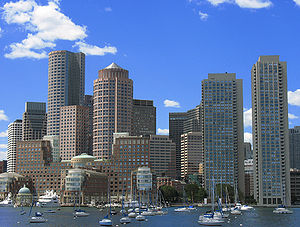
In 2000, the total population of New England was 13,922,517, roughly twice its 1910 population of 6,552,681.[21] If New England were one state, its population would rank 5th in the nation, behind Florida. Its land area, at 62,808.96 sq mi (162,672.45 km²), would rank 21st, behind Washington and ahead of Georgia. The region's average population density is 221.66 inhabitants/sq mi (85.59/km²), although a great disparity exists between its northern and southern portions, as noted below. It is much greater than that of the United States as a whole (79.56/sq mi) or even just the contiguous 48 states (94.48/sq mi).
Southern New England
Three quarters of New England's population and most of its major cities are concentrated in its three southernmost states: Connecticut, Massachusetts, and Rhode Island. Their combined population density is 786.83/sq mi, compared to northern New England's 63.56/sq mi (2000 census). The most populous state is Massachusetts, and the most populous city is Massachusetts' political and cultural capital, Boston. Western Massachusetts and Northwestern Connecticut are less densely populated than the rest of Southern New England.
Coastal New England
The coastline is more urban than western New England, which is typically rural, even in urban states like Massachusetts. This characteristic of the region's population is due mainly to historical factors; the original colonists settled mostly on the coastline of Massachusetts Bay. The only New England state without access to the Atlantic Ocean, Vermont, is also the least populated. After nearly 400 years, the region still maintains, for the most part, its historical population layout.
New England's coast is dotted with urban centers, such as Portland, Portsmouth, Boston, New Bedford, Fall River, Newport, Providence, New Haven, Bridgeport, and Stamford as well as smaller cities, like Newburyport, Gloucester, Biddeford, Bath, Rockland, and New London.
Urban New England
Southern New England forms an integral part of the BosWash megalopolis, a conglomeration of urban centers that spans from Boston to Washington, D.C.. The region includes three of the four most densely populated states in the United States; only New Jersey has a higher population density than the states of Rhode Island, Massachusetts, and Connecticut.
The Boston metropolitan area, which includes parts of southern New Hampshire, has a total population of approximately 4.4 million.[22] The most populous cities are as of 2000 census 2006 estimates in parenthesis):[23]
During the twentieth century, urban expansion in regions surrounding New York City has become an important economic influence on neighboring Connecticut, parts of which belong to the New York Metropolitan Area. The US Census Bureau groups Fairfield, New Haven and Litchfield counties in western Connecticut together with New York City, and other parts of New York and New Jersey as a combined statistical area.[24]
Economy
Several factors contribute to the uniquenesses of the New England economy. The region is geographically isolated from the rest of the United States, and is relatively small. It has a climate and a supply of natural resources such as granite, lobster, and codfish, that are different from many other parts of the country. Its population is concentrated on the coast and in its southern states, and its residents have a strong regional identity. America's textile industry began along the Blackstone River with the Slater Mill at Pawtucket, Rhode Island,[25] and was duplicated at similar sources of water power such as Woonsocket, Rhode Island, Uxbridge, Massachusetts, and Lawrence, Massachusetts. Exports consist mostly of industrial products, including specialized machines and weaponry, built by the region's educated workforce. About half of the region's exports consist of industrial and commercial machinery, such as computers and electronic and electrical equipment. This, when combined with instruments, chemicals, and transportation equipment, makes up about three-quarters of the region's exports. Granite is quarried at Barre, Vermont,[26] guns made at Springfield, Massachusetts, boats at Groton, Connecticut and Bath, Maine, and hand tools at Turners Falls, Massachusetts. Insurance is a driving force in and around Hartford, Connecticut.
New England also exports food products, ranging from fish to lobster, cranberries, Maine potatoes, and maple syrup. The service industry is also highly important, including tourism, education, financial and insurance services, plus architectural, building, and construction services. The U.S. Department of Commerce has called the New England economy a microcosm for the entire United States economy.[27]
As of May 2006, the unemployment rate in New England was 4.5%, below the national average. Vermont, with the lowest of the six states, had a rate of 3%. The highest was Rhode Island, with 5.5%. The metropolitan statistical area (MSA) with the lowest rate, 2.5%, was Burlington-South Burlington, in Vermont; the MSA with the highest rate, 7.9%, was Lawrence-Methuen-Salem, in Massachusetts and southern New Hampshire.[28]
New England is home to two of the ten poorest cities (by percentage living below the poverty line) in the United States: the state capital cities of Providence, Rhode Island and Hartford, Connecticut.[29] These cities have struggled as manufacturing, their traditional economic mainstay, has declined.[30]
With its rocky soil and climate, New England is not a strong agricultural region. Some New England states, however, are ranked highly among U.S. states for particular areas of production. Maine is ranked ninth for aquaculture,[31] Vermont fifteenth for dairy products,[32] and Connecticut and Massachusetts seventh and eleventh for tobacco, respectively.[33][34] Cranberries are grown in the Cape Cod - Plymouth area, and blueberries in Maine. As of 2005, the inflation-adjusted combined GSPs of the six states of New England was $623.1 billion, with Massachusetts contributing the most, and Vermont the least.[35] If a single state, this would rank fifth, just behind Florida.
Energy
The region is mostly very energy efficient compared to the country at large. Rhode Island has the lowest per capita energy consumption of any state in the country and five of the New England states placed in the lowest eleven. Maine, by contrast, had the 17th-highest per capita consumption.[36]
The six New England states collectively have the highest electricity costs in the nation. The best rates are in Vermont which stands 41st in the country; the worst, Rhode Island, is 50th (out of 51).[37]
Three of the six New England states are among the country highest consumers of nuclear power: Vermont (first, 73.7%), Connecticut (fourth, 48.9%), and New Hampshire (sixth, 46%).[38]
Politics
The early European settlers of New England were English Protestants fleeing religious persecution. This, however, did not prevent them from establishing colonies where religion was legislated to an extreme, and where those who deviated from the established doctrine were persecuted greatly. The early history of much of New England is marked by religious intolerance and harsh laws. In the beginning, there was no separation of church and state in these places, and the activities of the individual were severely restricted.[39] This contrasts sharply with the strong separation of church and state upon which Rhode Island was founded. Providence had no public burial ground and no Common until the year 1700 (64 years after its founding) because religious and government institutions were so rigorously kept distinct.[40]
New England and political thought
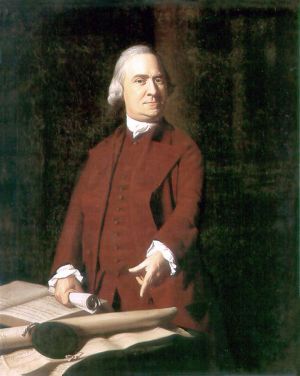
During the colonial period and the early years of the American republic, New England leaders like John Hancock, John Adams, and Samuel Adams joined those in Philadelphia and Virginia to assist and lead the newly-forming country. Daniel Webster was influential in expressing the political views of many New-Englanders in the early 19th century. At the time of the American Civil War, New England, the mid-Atlantic, and the Midwest, which had long since abolished slavery, united against the Confederate States of America, ending the practice in the United States. Henry David Thoreau, iconic New England writer and philosopher, made the case for civil disobedience and individualism, and has been adopted by the anarchist tradition. Benjamin Tucker, of Massachusetts, was a proponent of individualist anarchism. A modern example of this individualist spirit is the Free State Project in New Hampshire, and The Second Vermont Republic in Vermont.
While modern New England is known for its liberal tendencies, Puritan New England was highly intolerant of any deviation from strict social norms. During the 1960s civil rights era, Boston brewed with racial tension over school busing to end de facto segregation of its public schools.[41]
Eight presidents of the United States have been born in New England, however only five are usually affiliated with the area. They are, in chronological order: John Adams (Massachusetts), John Quincy Adams (Massachusetts), Franklin Pierce (New Hampshire), Chester A. Arthur (born in Vermont, affiliated with New York), Calvin Coolidge (born in Vermont, affiliated with Massachusetts), John F. Kennedy (Massachusetts), George H. W. Bush (born in Massachusetts, affiliated with Texas) and George W. Bush (born in Connecticut, affiliated with Texas).
Ten of the Speakers of the United States House of Representatives have been elected from New England. They are, in chronological order: Theodore Sedgwick (5th Speaker, Massachusetts), Joseph Bradley Varnum (7th Speaker, Massachuetts), Robert Charles Winthrop (22nd Speaker, Massachusetts), Nathaniel Prentice Banks (25th Speaker, Massachusetts), James G. Blaine (31st Speaker, Maine), Thomas Brackett Reed (36th and 38th, Maine), Frederick Gillett (42nd, Massachusetts), Joseph William Martin, Jr. (49th and 51st, Massachusetts), John McCormack (53rd, Massachusetts) and Tip O'Neill (55th, Massachusetts).
Contemporary politics
The dominant party in New England has been the Democratic Party. In every New England state, both legislative houses have a majority of Democratic representatives. Democrats hold half of New England's governor's positions: Maine, New Hampshire, and Massachusetts. While the governors of Connecticut, Vermont and Rhode Island are Republicans, the legislatures have veto-overriding Democratic super-majorities.[42][43][44]
Due to the liberal lean of the region, the state Republican parties and the elected Republican officials have been more politically and socially moderate than the national Republican Party, including Congressman Christopher Shays of Connecticut, Senators Susan Collins and Olympia Snowe of Maine as well as Governors Donald Carcieri (RI), Jodi Rell (CT) and Jim Douglas (VT). Republican Senators John E. Sununu and Judd Gregg of New Hampshire have been moderate-to-conservative, but this is reflective of New Hampshire being the most conservative state in the region, as New Hampshire, prior to the 2006 election, had the only Republican-controlled legislature in New England.
Collectively, New England has as many electoral votes (34) as Texas, though they are decided by each state. Comparatively, New England has better electoral representation — the population of New England is over 14 million while the population of Texas just under 24 million. In the 2000 presidential election, Democratic candidate Al Gore carried all of the New England states except for New Hampshire, and in 2004, John Kerry, a New Englander himself, won all six New England states.[45] In both the 2000 and 2004 presidential elections, every congressional district with the exception of New Hampshire's 1st district were won by Gore and Kerry respectively. During the 2008 Democratic primaries, Hillary Clinton won the three New England states containing Greater Boston (Massachusetts, Rhode Island, and New Hampshire), while Barack Obama won the three that did not (Connecticut, Maine, and Vermont). In the 2008 presidential election, the Democratic candidate, Barack Obama, has consistently polled as the winner in New England states by a large margin except in New Hampshire.[46][47]
Government
Town meetings
A derivative of meetings held by church elders, town meetings were and are an integral part of governance of many New England towns. At such meetings, any citizen of the town may discuss issues with other members of the community and vote on them. This is the strongest example of direct democracy in the United States today, and the form of dialogue has been adopted under certain circumstances elsewhere, most strongly in the states closest to the region, such as New York, New Jersey and Pennsylvania. Such a strong democratic tradition was even apparent in the early 19th century, when Alexis de Tocqueville wrote in Democracy in America that in
- New England, where education and liberty are the daughters of morality and religion, where society has acquired age and stability enough to enable it to form principles and hold fixed habits, the common people are accustomed to respect intellectual and moral superiority and to submit to it without complaint, although they set at naught all those privileges which wealth and birth have introduced among mankind. In New England, consequently, the democracy makes a more judicious choice than it does elsewhere.
James Madison, a critic of town meetings, however, wrote in Federalist No. 55 that, regardless of the assembly, "passion never fails to wrest the scepter from reason. Had every Athenian citizen been a Socrates, every Athenian assembly would still have been a mob."[48] Today, the use and effectiveness of town meetings, as well as the possible application of the format to other regions and countries, is still discussed by scholars.[49]
Notable laws
New England abolished the death penalty for crimes like robbery and burglary in the 19th century, before much of the rest of the United States did. New Hampshire and Connecticut are the only New England states that allow capital punishment,[50] although New Hampshire currently has no death row inmates and has not held an execution since 1939. Connecticut held an execution in 2005, the first in New England since 1960, when Connecticut last executed a prisoner.[51]
Vermont was the first state to allow civil unions between same sex couples, and Massachusetts was the first state to allow same-sex marriage. In 2005, Connecticut also began to allow civil unions. In 2008, some form of same-sex unions will be in all New England states except Rhode Island, though the state does recognize Massachusetts marriages for its residents.[52]
In 2006, Massachusetts adopted a health care reform that requires nearly all state residents obtain health insurance.[53]
Education
Colleges and universities
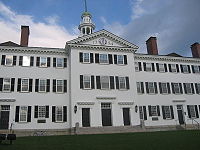
New England contains some of the oldest and most renowned institutions of higher learning in the United States. The first such institution, subsequently named Harvard College, was founded at Cambridge, Massachusetts, to train preachers, in 1636. Yale University was founded in Branford, Connecticut, in 1701, and awarded the nation's first doctoral (Ph.D.) degree in 1861. Yale moved to New Haven, Connecticut, in 1718 where it has remained to the present day. Brown University, the first college in the nation to accept students of all religious affiliations and seventh-oldest institution of higher learning, was founded in Providence, Rhode Island, in 1764. Dartmouth College was founded five years later in Hanover, New Hampshire, with the mission of educating the local American Indian population as well as English youth. New England also contains the Massachusetts Institute of Technology (MIT).
Public education
New England states fund their public schools well, with expenditures per student, and teacher salaries above the national median. As of 2005, the National Education Association ranked Connecticut with the highest-paid teachers in the country. Massachusetts and Rhode Island ranked eighth and ninth, respectively. Every state but New Hampshire is in the top ten for educational spending per student. Boston Latin School is the oldest public high school in America. Several signers of the Declaration of Independence attended Boston Latin.[54]
Culture
New England has a history of shared heritage and culture primarily shaped by waves of immigration from Europe. A cultural divide, however, also exists between urban New Englanders living along the densely-populated coastline and rural New Englanders in western Massachusetts, Northwestern Connecticut, Vermont, New Hampshire, and Maine, where population density is low.[55]
Connecticut has two cultural and demographic trends: the southwestern part of the state is largely suburban (a contains most of the state's population), alongside the cities Bridgeport, New Haven, Waterbury, Stamford, and Danbury, and as part of the New York metropolitan area, is greatly influenced by New York City. Eastern Connecticut is culturally similar to neighboring Massachusetts and Rhode Island. Long-time residents of this area are often referred to as "Swamp Yankees."[56] Caught in between these two cultures lies central Connecticut. The region is split fairly evenly between New York oriented people and Boston oriented people, making for an interesting mix (or clash) of culture. An example of Connecticut's cultural dichotomy can be found in residents' allegiance to sports teams. Eastern Connecticut residents tend to support Boston teams, unlike the rest of the state who tend to be loyal to New York teams.[57] Television broadcasts in Hartford and New Haven typically give equal coverage to sports teams from both Boston and New York.
Cultural roots
The first European colonists of New England were focused on maritime affairs such as whaling and fishing, rather than more continental inclinations such as surplus farming. One of the older American regions, New England has developed a distinct cuisine, dialect, architecture, and government. New England cuisine is known for its emphasis on seafood and dairy; clam chowder, lobster, and other products of the sea are among some of the region's most popular foods, such as New Haven's famous white clam pizza.
Social activities and music
In much of rural New England, particularly Maine, Acadian, and Québécois culture dominate the region's music and dance. Contra dancing and country square dancing are popular throughout New England, usually backed by live Irish, Acadian, or other folk music. In some towns of Massachusetts, Rhode Island, and Connecticut, Portuguese music is preserved by Portuguese American communities.
Traditional knitting, quilting and rug hooking circles in rural New England have become less common; church, sports, and town government are more typical social activities. Ice cream parlors dot the countryside. In fact, New England leads the country in ice cream consumption per capita.[58][59]
Literature
New England has been the birthplace of many American authors and poets. Ralph Waldo Emerson was born near Boston. Henry David Thoreau was born in Concord, Massachusetts, where he famously lived, for some time, by Walden Pond, on Emerson's land. Nathaniel Hawthorne, romantic era writer, was born in historical Salem; later, he would live in Concord at the same time as Emerson and Thoreau. Emily Dickinson lived most of her life in Amherst, Massachusetts. Henry Wadsworth Longfellow was from Portland, Maine. Edgar Allan Poe was born in Boston. According to many reports, the famed Mother Goose, the author of fairy tales and nursery rhymes was originally a person named Elizabeth Foster Goose or Mary Goose who lived in Boston. Poets James Russell Lowell, Amy Lowell, and Robert Lowell, a Confessionalist poet and teacher of Sylvia Plath, were all New England natives. Anne Sexton, also taught by Lowell, was born and died in Massachusetts. Much of the work of Nobel Prize laureate Eugene O'Neill is often associated with the city of New London, Connecticut where he spent many summers. The 14th U.S. Poet Laureate Donald Hall, a New Hampshire resident, continues the line of renowned New England poets. Noah Webster, the Father of American Scholarship and Education, was born in West Hartford, Connecticut. Pulitzer Prize winning poets Edwin Arlington Robinson, Edna St. Vincent Millay and Robert P. T. Coffin were born in Maine. Poets Stanley Kunitz and Elizabeth Bishop were both born in Worcester, Massachusetts. Pulitzer Prize winning poet Galway Kinnell was born in Providence, Rhode Island. Oliver La Farge was a New Englander of French and Narragansett descent, won the Pulitzer Prize for the Novel, the predecessor to the Pulitzer Prize for Fiction, in 1930 for his book Laughing Boy. John P. Marquand grew up in Newburyport, Massachusetts. Novelist Edwin O'Connor, who was also known as a radio personality and journalist, won the Pulitzer Prize for Fiction for his novel The Edge of Sadness. Pulitzer Prize winner John Cheever, a novelist and short story writer, was born in Quincy, Massachusetts set most of his fiction in old New England villages based on various South Shore towns around his birthcity. E. Annie Proulx was born in Norwich, Connecticut. David Lindsay-Abaire won the Pulitzer Prize for Drama in 2007 for his play Rabbit Hole was raised in Boston.
Ethan Frome, written in 1911 by Edith Wharton, is set in turn-of-the-century New England, in the fictitious town of Starkfield, Massachusetts. Like much literature of the region, it plays off themes of isolation and hopelessness. New England is also the setting for most of the gothic horror stories of H. P. Lovecraft, who lived his life in Providence, Rhode Island. Real New England towns such as Ipswich, Newburyport, Rowley, and Marblehead are given fictional names such as Dunwich, Arkham, Innsmouth, Kingsport, and Miskatonic and then featured quite often in his stories. Lovecraft had an immense appreciation for the New England area, and when he had to re-locate to New York City, he longed to return to his beloved native land.
The region has also drawn the attention of authors and poets from other parts of the United States. Mark Twain found Hartford to be the most beautiful city in the United States and made it his home, and wrote his masterpieces there. He lived directly next door to Harriett Beecher Stowe, a local whose most famous work is Uncle Tom's Cabin. John Updike, originally from Pennsylvania, eventually moved to Ipswich, Massachusetts, which served as the model for the fictional New England town of Tarbox in his 1968 novel Couples. Robert Frost was born in California, but moved to Massachusetts during his teen years and published his first poem in Lawrence; his frequent use of New England settings and themes ensured that he would be associated with the region. Arthur Miller, a New York City native, used New England as the setting for some of his works, most notably The Crucible. Herman Melville, originally for New York City, bought the house now known as Arrowhead in Pittsfield, Massachusetts, and while he lived there he wrote his greatest novel Moby-Dick. Poet Maxine Kumin was born in Philadelphia, currently resides in Warner, New Hampshire. Pulitzer Prize winning poet Mary Oliver was born in Maple Heights, Ohio has lived in Provincetown, Massachusetts for the last forty years. Charles Simic who was born in Belgrade, Serbia (at that time Yugoslavia) grew up in Chicago and lives in Strafford, New Hampshire, on the shore of Bow Lake and is the professor emeritus of American literature and creative writing at the University of New Hampshire. Pulitzer Prize winning novelist and short story writer Steven Millhauser, who was born in New York City and short story Eisenheim the Illusionist was adapted into the 2006 film was raised in Connecticut.
More recently, Stephen King, born in Portland, Maine, has used the small towns of his home state as the setting for much of his horror fiction, with several of his stories taking place in or near the fictional town of Castle Rock. Just to the south, Exeter, New Hampshire was the birthplace of best-selling novelist John Irving and Dan Brown, author of The Da Vinci Code. Rick Moody has set many of his works in southern New England, focusing on wealthy families of suburban Connecticut's Gold Coast and their battles with addiction and anomie. Derek Walcott, a playwright and poet, who won Nobel Prize for Literature in 1992, teaches poetry at Boston University. Pulitzer Prize winner Cormac McCarthy, whose novel No Country for Old Men was made into the Academy Award for Best Picture winning film in 2007, was born in Providence (although he moved to Tennessee when he was a boy).
Largely on the strength of its local writers, Boston was for some years the center of the U.S. publishing industry, before being overtaken by New York in the middle of the nineteenth century. Boston remains the home of publishers Houghton Mifflin and Pearson Education, and was the longtime home of literary magazine The Atlantic Monthly. Merriam-Webster is based in Springfield, Massachusetts. Yankee, a magazine for New Englanders, is based in Dublin, New Hampshire.
Sports
Two popular American sports were invented in New England. Basketball was invented by James Naismith in Springfield, Massachusetts, in 1891.[60] Volleyball was invented by William G. Morgan in Holyoke, Massachusetts, in 1895.[61]
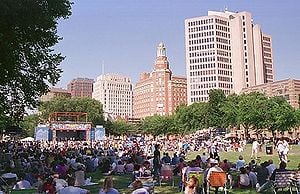
Recreation
The Appalachian Mountains run through northern New England, which make for excellent skiing. Vermont, New Hampshire, and Maine are home to various ski resorts.
Cape Cod, Nantucket, and Martha's Vineyard in Massachusetts are popular tourist destinations for their small town charm and beaches. All have restrictive zoning laws to prevent sprawl and overdevelopment.
The coastal New England states are home to many oceanfront beaches. Acadia National Park, off the coast of Maine, preserves most of Mount Desert Island and includes mountains, an ocean shoreline, woodlands, and lakes.
Notes
- ↑ Swindler, William F., ed; Sources and Documents of United States Constitutions. 10 Volumes; Dobbs Ferry, New York; Oceana Publications, 1973-1979. Volume 5: Pages 16-26.
- ↑ 2.0 2.1 O’Callaghan, E. B., ed; Documents Relative to the Colonial History of the State of New York, Volumes 1 - 11.;Albany, New York; 1853-1887 ; Volume 3: Page 537
- ↑ 3.0 3.1 Craven, Wesley Frank; Colonies in Transition, 1660 – 1713.;New York, New York: Harper and Row, 1968. Page 224.
- ↑ 4.0 4.1 Morris, Gerald E., and Kelly, Richard D., eds; Maine Bicentennial Atlas: An Historical Survey. Plate 11. Portland, Maine; Portland Historical Society; 1976.
- ↑ State & County QuickFacts. US Census Bureau. Retrieved 2008-07-24.
- ↑ New England. Encyclopædia Britannica, Inc.. Retrieved 2008-07-24.
- ↑ 7.0 7.1 "New England," Microsoft Encarta Online Encyclopedia 2006 http://encarta.msn.com © 1997–2006 Microsoft Corporation. All Rights Reserved.
- ↑ The Story of the World Record Wind. Mount Washington Observatory. Retrieved 2007-08-13.
- ↑ New England's Fall Foliage. Discover New England. Retrieved 2007-08-13.
- ↑ New England Climate Initiative. Available at: http://www.neci.sr.unh.edu/neccwaq.html#4 (Accessed July 26, 2006).
- ↑ David B. Martucci. THE NEW ENGLAND FLAG. D. MARTUCCI. Retrieved 2008-07-25.
- ↑ An Earth Without People. Scientific American, Inc.. Retrieved 2007-08-13.
- ↑ 13.0 13.1 13.2 13.3 Paullin, Charles O.; Atlas of the Historical Geography of the United States.; Edited by John K. Wright; New York, New York and Washington, D.C.: Carnegie Institution of Washington and American Geographical Society of New York, 1932:Plate 42.; ; Excellent section on International and interstate boundary disputes.
- ↑ 14.0 14.1 14.2 14.3 Swindler, William F.., ed. Sources and Documents of United States Constitutions. 10 Volumes; Dobbs Ferry, New York; Oceana Publications, 1973-1979; Vol. 10; Pps. 17-23; The most complete and up-to-date compilation for the states.
- ↑ 15.0 15.1 15.2 15.3 Van Zandt, Franklin K.; Boundaries of the United States and the Several States; Geological Survey Professional Paper 909. Washington, D.C.; Government Printing Office; 1976. The standard compilation for its subject.; Page 92.
- ↑ "In addition to claiming land for England and bringing the faith of the Church of England to the native peoples, each of the Virginia Companies was also enjoined both by the crown and its members to make a tidy profit by whatever means it found expedient." http://www.nps.gov/colo/Jthanout/TobaccoHistory.html
- ↑ The Virginia Company: Lecture Transcript One. Annenberg Media. Retrieved 2008-08-25.
- ↑ New England. Encyclopædia Britannica, Inc.. Retrieved 2008-08-25.
- ↑ "...joint stock company organized in 1620 by a charter from the British crown with authority to colonize and govern the area now known as New England." New England, Council for. (2006). In Encyclopædia Britannica. Retrieved July 13, 2006, from Encyclopædia Britannica Premium Service: http://www.britannica.com/eb/article?tocId=9055458
- ↑ James Schouler, History of the United States vol 1 (New York: Dodd, Mead & Company. 1891; copyright expired).
- ↑ NEW ENGLAND POPULATION BY STATE: 1800 - 2000. Rhode Island Division of Planning. Retrieved 2008-08-25.
- ↑ U.S. Census Bureau - Metropolitan and micropolitan statistical area population and estimated components of change: April 1, 2000 to July 1, 2006
- ↑ (Population Estimates for Places over 100,000: 2000 to 2006. US Census Bureau. Retrieved 2007-06-29.)
- ↑ Population Division, U.S. Census Bureau. Combined Statistical Areas and Component Core Based Statistical Areas, December 2005. Retrieved 2006-06-15.
- ↑ Blackstone River Valley National Heritage Corridor - History & Culture (U.S. National Park Service). Department of the Interior. Retrieved 2008-09-21.
- ↑ Rich, Jack C (1988). Materials and Methods of Sculpture. Dover Publications.
- ↑ Background on the New England Economy.. U.S. Department of Commerce. Retrieved 2006-07-19.
- ↑ New England - Labor Force Statistics. U.S. Dept. of Labor. Retrieved 2008-09-21.
- ↑
 PDF
PDF
- ↑ New England has the Highest Increase in Income Disparity in the Nation. The Carsey Institute: University of New Hampshire. Retrieved 2007-06-06.
- ↑ U.S. Department of Agriculture, National Agricultural Statistics Service, and has abundant potato fields in its northeast part. Available at:
 PDF
PDF
- ↑ U.S. Department of Agriculture, National Agricultural Statistics Service. Available at:
 PDF
PDF
- ↑ U.S. Department of Agriculture, National Agricultural Statistics Service. Available at:
 PDF
PDF
- ↑ U.S. Department of Agriculture, National Agricultural Statistics Service. Available at:
 PDF
PDF
- ↑ Bureau of Economic Analysis. Available at: http://www.bea.gov/bea/newsrel/gspnewsrelease.htm (Accessed July 19, 2005).
- ↑ Energy Consumption: Red State and Blue State Comparisons. sustainablemiddleclass.com.
- ↑ Electricity Rate Comparison by State. Government of Nebraska. Retrieved 2008-08-20.
- ↑ Hemmingway, Sam (July 20, 2008). Nukes by the numbers. Burlington Free Press.
- ↑ History of the United States of America, by Henry William Elson, The MacMillan Company, New York, 1904. Chapter VI p. 127–130. Available at: http://www.usgennet.org/usa/topic/colonial/book/chap6_3.html (Accessed July 19, 2006).
- ↑ Woodward, Wm McKenzie. Guide to Providence Architecture. 1st ed. 2003: United States. p135.
- ↑ "School Integration in Boston: Introduction." Available at: http://www.watson.org/~lisa/blackhistory/school-integration/boston/index.html (Accessed July 19, 2006)
- ↑ Christopher Keating. State Democrats Have Veto-Proof Majorities. Hartford Courant. Retrieved 2007-11-15.
- ↑ StateVote 2006. State Legislatures Magazine National Conference of State Legislatures;. Retrieved 2006-11-15.
- ↑ "Connecticut: The Slow Death of the State G.O.P.". New York Times,". Retrieved 2007-11-15.
- ↑ "2006 Political Party Breakdown by State.". The Green Papers. Retrieved 2006-07-19.
- ↑ Track the electoral college and congressional elections with a red/blue map of the US updated daily using the latest state polls.. Retrieved 2008-06-10.
- ↑ FiveThirtyEight: Electoral Projections Done Right.. Retrieved 2008-06-10.
- ↑ Madison, James. Federalist No. 55. Quotation attributed at http://www.ilsr.org/newrules/gov/townmtg.html (Accessed July 19, 2006).
- ↑ See Harvard lecturer Robert I. Rotberg review REAL DEMOCRACY: THE NEW ENGLAND TOWN MEETING AND HOW IT WORKS at http://democraciaparticipativa.net/mambo/content/view/79/36/ (Accessed July 19, 2006).
- ↑ "Death Penalty Information Center." Available at: http://www.deathpenaltyinfo.org/state/ (Accessed July 19, 2006).
- ↑ "New Hampshire has not executed anyone since 1939 and has no one on death row. Seven inmates are waiting to die in Connecticut, which conducted New England's last execution in 1960." FOXNews.com. "Supreme Court Lifts Order Blocking Connecticut Execution." Available at: http://www.foxnews.com/story/0,2933,145681,00.html (Accessed July 19, 2006).
- ↑ Marrying in Massachusetts: A Guide for Same-Sex Couples. glad.org. Retrieved 2007-06-11.
- ↑ Fahrenthold, David A. "Mass. Bill Requires Health Coverage, " The Washington Post April 5, 2006; Page A01. Retrieved December 6, 2006. See also Massachusetts 2006 Health Reform Statute.
- ↑ "She graduated from the elite Boston Latin School, the oldest high school in America, in 1999." Taken from the New York Post, available at: http://www.nypost.com/news/regionalnews/64304.htm (Accessed July 19, 2006).
- ↑ New England Population History. Brown University. Retrieved 8-26-2008.
- ↑ Ruth Schell, "Swamp Yankee," American Speech, 1963, Volume 38, No.2 (The American Dialect Society, Published by Duke University Press), pg. 121–123. accessed through JSTOR
- ↑ Does a Connecticut Yankee Wear Red Sox?. The Idea Logical Company, Inc.. Retrieved 2008-08-26.
- ↑ New England's best ice cream. The Boston Globe. Retrieved 2008-01-14.
- ↑ Surviving the New England Winter: You Scream, I Scream, Ice Cream!. The Harvard Harbus. Retrieved 2008-01-14.
- ↑ History of Basketball - James Naismith
- ↑ History Of Volleyball
- ↑ New Haven Travel Guide. wcities. Retrieved 2007-12-04.
ReferencesISBN links support NWE through referral fees
- Adams, James Truslow. The Founding of New England (1921)
- Adams, James Truslow. Revolutionary New England, 1691–1776 (1923)
- Adams, James Truslow. New England in the Republic, 1776–1850 (1926)
- Andrews, Charles M. The Fathers of New England: A Chronicle of the Puritan Commonwealths (1919), short survey.
- Axtell, James, ed. The American People in Colonial New England (1973), new social history
- Black, John D. The rural economy of New England: a regional study (1950
- Brewer, Daniel Chauncey. Conquest of New England by the Immigrant (1926).
- Conforti, Joseph A. Imagining New England: Explorations of Regional Identity from the Pilgrims to the Mid-Twentieth Century (2001)
- Dwight, Timothy. Travels Through New England and New York (circa 1800) 4 vol. (1969) Online at: vol 1; vol 2; vol 3; vol 4
- Hall, Donald, foreword, Feintuch, Burt and Watters, David H., editors, Encyclopedia of New England (2005)
- Karlsen, Carol F. The Devil in the Shape of a Woman: Witchcraft in Colonial New England (1998)
- Lilly, Lamberth. History of New England (1847)
- Lockridge, Kenneth A. A New England Town: The First Hundred Years: Dedham, Massachusetts, 1636–1736 (1985), new social history
- McPhetres, S. A. A political manual for the campaign of 1868, for use in the New England states, containing the population and latest election returns of every town (1868)
- Palfrey, John Gorham. History of New England (5 vol 1859–90)
- Zimmerman, Joseph F. The New England Town Meeting: Democracy in Action (1999)
- NEW YORK: Atlas of Historical County Boundaries; John H. Long, Editor; Compiled by Kathryn Ford Thorne; A Project of the Dr. William M. Scholl Center for Family and Community History; The new Berry Library; Simon & Schuster; 1993.
- Contributors: U.S. Census Bureau.
 PDF. Retrieved May 11, 2005
PDF. Retrieved May 11, 2005 - The Washington Post, Mass. Bill Requires Health Coverage
- The Guardian, Movers and Shakers
External links
- Political
- Historic
- Maps
- Historic USGS Maps of New England & NY
- Map of New England. From the 1871 Atlas of Massachusetts by Walling and Gray. Click on image to get VERY large image.
- Miscellaneous
Credits
New World Encyclopedia writers and editors rewrote and completed the Wikipedia article in accordance with New World Encyclopedia standards. This article abides by terms of the Creative Commons CC-by-sa 3.0 License (CC-by-sa), which may be used and disseminated with proper attribution. Credit is due under the terms of this license that can reference both the New World Encyclopedia contributors and the selfless volunteer contributors of the Wikimedia Foundation. To cite this article click here for a list of acceptable citing formats.The history of earlier contributions by wikipedians is accessible to researchers here:
The history of this article since it was imported to New World Encyclopedia:
Note: Some restrictions may apply to use of individual images which are separately licensed.
